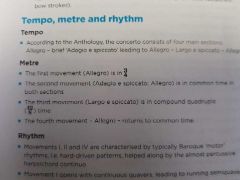![]()
![]()
![]()
Use LEFT and RIGHT arrow keys to navigate between flashcards;
Use UP and DOWN arrow keys to flip the card;
H to show hint;
A reads text to speech;
14 Cards in this Set
- Front
- Back
- 3rd side (hint)
|
Concerto Grosso |
A work for a group of soloists - in this case two violins and a cello - supported by a group string players and a harpsichord/organ continuo. |
|
|
|
L'estro Armonico |
("Harmonic fancy" or "Harmonic inspiration") The work of Vivaldi's consisting of 12 concertos (including Concerto in Dminor). |
|
|
|
Continuo |
Short for "basso continuo", the continuo instruments form the accompaniment in Baroque music. |
|
|
|
Spiccato |
Performed with short, abrupt and rebounding motions of the bow. (Basically bouncing the bow off the strings). |
|
|
|
Ripieno |
All instruments playing, tutti. |
|
|
|
Figured bass |
A system of harmonic shorthand, which conveyed to the keyboard player the chords to be supplied. Figures indicate the intervals above the bass. (The little numbers in the continuo part) |
|
|
|
Terraced dynamics |
Bold, abrupt contrasts between loud and soft. No crescendos or dimuendos, no use of 'middle' dynamics (ie mp or mf). |
|
|
|
Metre |

|
|
|
|
Motor rhythms |
Hard driven rhythms, helped along with almost percussive harpsichord continuo. |
|
|
|
Siciliano rhythm |

A rhythmic cell consisting of: dotted quaver - semiquaver - quaver |
|
|
|
Neapolitan 6th chord |

Take the progression iiº6 - V7 - i in a minor key, and use the lowered second degree of the scale for the supertonic triad.
°6 just means augmented (°) 6th.
In this example (in Cminor) they've gone for a 2 5 1, which we touched upon when writing chorales.
Since this is a minor key, the ii chord becomes an augmented 6th chord (since the minor key has a raised 7th, which is the 6th degree of the ii chord).
To become Neapolitan, the ii°6 chord borrows from the phrygian scale, which can be seen with the Db in the second example. |
Seen in movement 3, bar 2, beat 2. |
|
|
Tierce de Picardie |
A major third in the final chord of a piece in a minor key. |
Seen in mvt 2 at bar 70, leading into the tonic minor. |
|
|
Ritornello |
Tutti section. |
|
|
|
Canon |
Consistent note-for-note imitation of one melodic line by another, in which the second starts after the first. |
|

